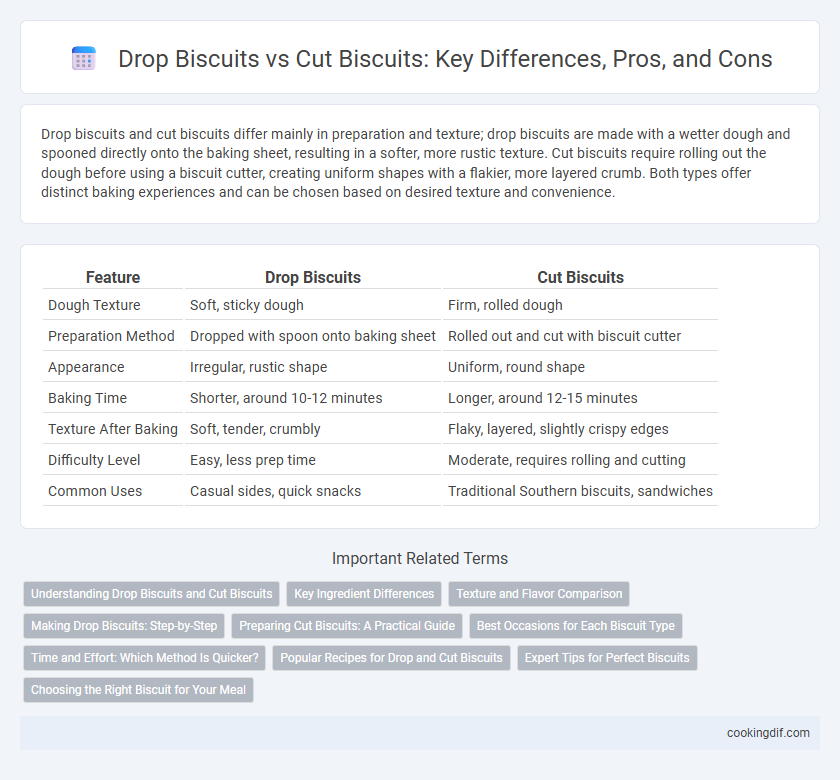Drop biscuits and cut biscuits differ mainly in preparation and texture; drop biscuits are made with a wetter dough and spooned directly onto the baking sheet, resulting in a softer, more rustic texture. Cut biscuits require rolling out the dough before using a biscuit cutter, creating uniform shapes with a flakier, more layered crumb. Both types offer distinct baking experiences and can be chosen based on desired texture and convenience.
Table of Comparison
| Feature | Drop Biscuits | Cut Biscuits |
|---|---|---|
| Dough Texture | Soft, sticky dough | Firm, rolled dough |
| Preparation Method | Dropped with spoon onto baking sheet | Rolled out and cut with biscuit cutter |
| Appearance | Irregular, rustic shape | Uniform, round shape |
| Baking Time | Shorter, around 10-12 minutes | Longer, around 12-15 minutes |
| Texture After Baking | Soft, tender, crumbly | Flaky, layered, slightly crispy edges |
| Difficulty Level | Easy, less prep time | Moderate, requires rolling and cutting |
| Common Uses | Casual sides, quick snacks | Traditional Southern biscuits, sandwiches |
Understanding Drop Biscuits and Cut Biscuits
Drop biscuits are made from a wetter dough that is spooned or dropped onto a baking sheet, resulting in a more rustic, crumbly texture. Cut biscuits use a stiffer dough that is rolled out and cut with a biscuit cutter, producing a uniform shape with flaky layers. Understanding these key differences helps bakers choose the right biscuit style for their desired texture and presentation.
Key Ingredient Differences
Drop biscuits rely heavily on liquid ingredients like milk or buttermilk to create a thick batter, resulting in a soft, tender texture without the need for rolling or cutting. Cut biscuits use a firmer dough consisting of flour, solid fat such as butter or shortening, and minimal liquid, which is rolled out and cut into shapes to achieve flaky layers. The key ingredient difference lies in the ratio and form of fat and liquid, directly impacting the biscuit's texture and preparation method.
Texture and Flavor Comparison
Drop biscuits have a softer, more tender texture due to higher moisture content and less handling of the dough, resulting in a moist, fluffy crumb and a slightly buttery flavor. Cut biscuits, made by rolling and cutting the dough, offer a firmer, flakier texture with defined layers, producing a richer, more biscuit-forward taste. The difference in dough preparation and baking methods directly influences the contrast in texture and depth of flavor between drop and cut biscuits.
Making Drop Biscuits: Step-by-Step
Making drop biscuits begins by mixing flour, baking powder, salt, and cold butter until the mixture forms coarse crumbs. Next, cold milk or buttermilk is stirred in just until the dough comes together, avoiding overmixing to keep the biscuits tender. Finally, spooning the dough onto a baking sheet in mounds and baking at 425degF for 12-15 minutes produces soft, flaky drop biscuits with a golden crust.
Preparing Cut Biscuits: A Practical Guide
Preparing cut biscuits involves rolling out chilled dough to an even thickness, typically around 1/2 inch, and using a sharp biscuit cutter to ensure clean edges. Maintaining cold ingredients and minimal handling prevents gluten development, resulting in flaky, tender biscuits. Resting the dough briefly before baking allows the dough to relax and helps achieve optimal rise and texture.
Best Occasions for Each Biscuit Type
Drop biscuits, known for their soft, tender texture and rustic appearance, are ideal for casual meals like family breakfasts and potlucks where quick preparation is preferred. Cut biscuits, characterized by their uniform shape and flaky layers, are best suited for formal occasions or holiday dinners that call for elegant presentation and traditional Southern fare. Both types pair well with gravies or jams, but drop biscuits shine in everyday comfort food settings, while cut biscuits elevate festive gatherings.
Time and Effort: Which Method Is Quicker?
Drop biscuits require less time and effort compared to cut biscuits since the dough is simply spooned onto the baking sheet without the need for rolling or cutting. Cut biscuits involve rolling out the dough and using a cutter, which takes more hands-on preparation and can extend the overall time. For quick baking with minimal effort, drop biscuits are the more efficient choice.
Popular Recipes for Drop and Cut Biscuits
Drop biscuits feature a soft, thick texture achieved by spooning high-moisture dough onto baking sheets, popular in recipes like buttermilk cheddar drop biscuits and sweet potato drop biscuits. Cut biscuits rely on a rolled dough that is cut into shapes, producing flaky layers seen in classic Southern buttermilk biscuits and flaky cheddar herb cut biscuits. Both types are staples in comfort food recipes, complementing dishes such as fried chicken and hearty stews.
Expert Tips for Perfect Biscuits
Drop biscuits require a wetter dough and a spoon or scoop for portioning, resulting in a softer, fluffier texture, perfect for quick, rustic biscuits. Cut biscuits depend on a floured surface and biscuit cutter to create uniform layers, yielding a flaky, buttery crumb ideal for classic presentations. Expert tips include chilling the dough for cut biscuits to maintain flaky layers and avoiding overmixing drop biscuit batter to ensure tenderness.
Choosing the Right Biscuit for Your Meal
Drop biscuits deliver a softer, fluffier texture ideal for stews or breakfast dishes, while cut biscuits offer a flaky, buttery consistency perfect as a side for hearty meals. Consider moisture content and rise when selecting; drop biscuits use more liquid and baking powder for a tender crumb, whereas cut biscuits rely on cold butter and minimal handling for layered flakiness. Matching biscuit type to your meal enhances flavor pairing and overall satisfaction.
Drop biscuits vs cut biscuits Infographic

 cookingdif.com
cookingdif.com